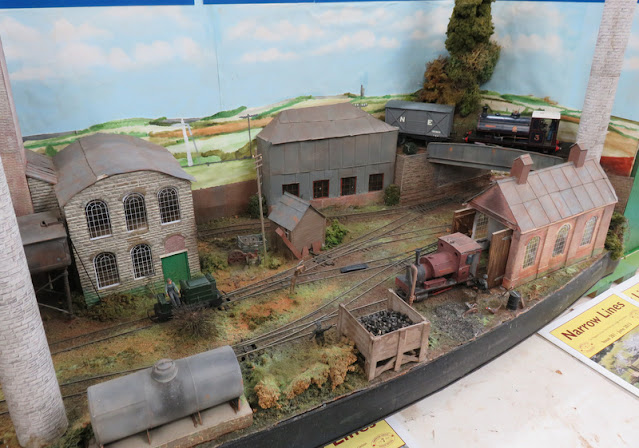The Amberley Railway Gala is a regular in the calendar of the Sussex Downs 009 Group, we always provide a 009 Society stand with the showcase and demonstrations, and often layouts too. Of course last year there was no Gala, but this year the event went ahead, albeit a little different to normal, and I went along today to help with our group stand. The exhibition was smaller than previous Galas, although the large railway shed allowed plenty of space for social distances and large doors for ventilation. With our group only recently having started meeting in person again after months of Zoom meetings, it was great to have the first railway event since March last year.
Our stand had more tables than usual to allow social distancing. As well as the showcase and demo layout, Simon brought a small "pizza" layout. It looks like he is wishing it had more operational interest!
Tim also brought a small layout, "The Old Quarry", which features a passing loop and some attractive scenery. Despite very tight curves the running was excellent.
There were a few other layouts, mostly small like this O-16.5 shunting layout, although there was a larger modular American On30 layout too.
Outside there was steam courtesy of Polar Bear, though the other steam loco Peter is undergoing overhaul. There were no visiting locos, miniature railways or traction engines though.
Even so, the usual Gala intensive service was operated with the larger diesels helping with passenger trains, and the smaller i/c and battery locos running demonstration goods trains. The trains seemed reasonably well patronised, although it definitely seemed quieter than previous Gala weekends.
The usual afternoon loco parade took place, and I'm sure the volunteers enjoyed getting all the toys out as much as the socially distanced crowd enjoyed seeing them all.
There's a great collection of NG locos at Amberley, but it is nice to see a new restoration. This little Brush battery-electric was built for ammunition factory use in 1917. It's cute and delightfully simple, though the ancient motor (which fills all the space under the seat) is not very powerful, and I can report that the cab is more cramped than it looks!
So life may not be back to normal quite yet, but it this was an encouraging step along the way.

















